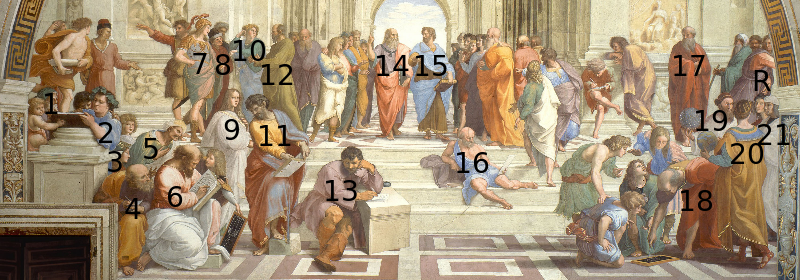Skolen i Athen

Skolen i Athen (italiensk Scuola di Atene) er en fresko i rummet Stanza della Segnatura i Vatikanpaladset i Rom. Freskoen er et af de mest kendte værker af renæssancemaleren Rafael, som også malede de tre andre freskoer i det samme rum. Rafael udførte freskoen fra 1509 til 1511 og motivet viser mange af antikkens mest kendte græske filosofer.
Stanza della Segnatura var det første i en række rum, som Rafael blev bestilt til at dekorere, og Skolen i Athen, som repræsenterer filosofi, var sandsynligvis det tredje af malerierne i dette rum, som han færdiggjorde, efter La Disputa (teologi) på den modsatte væg og Parnassus (litteratur).[1] Skolen i Athen er længe blevet set som "Rafaels mesterværk og det perfekte billede på den klassiske ånd i renæssancen".[2]
Personer
[redigér | rediger kildetekst]En komplet liste over de afbildede personer er givet nedenfor:[3]

1: Zenon fra Kition[4] 2: Epikur[4] 3: ukendt[5] 4: Boëthius[4] eller Anaximander[4] 5: Averroës[4] 6: Pythagoras[4],[6] 7: Alkibiades[4] eller Alexander den Store[4] eller Perikles[7] eller Xenofon[8] 8: Antisthenes[4] eller Xenofon[4] 9: ukendt,[5] muligvisGiovanni Pico della Mirandola,[8] (nogle gange identificeret som Hypatia i moderne populære kilder)[9] eller Fornarina en personificering af Kærlighed[10] (Francesco Maria della Rovere?)[3] 10: Aeschines[4] 11: Parmenides[3] eller Nicomachus[3] 12: Sokrates[4][8] eller Anaxagoras[7] 13: Heraklit[3] (Michelangelo?)[3] 14: Platon[3] (Leonardo da Vinci?)[11] 15: Aristoteles[3] (Giuliano da Sangallo?)[12] 16: Diogenes af Sinope[3] eller Sokrates[7] 17: Plotin?[3] er Solon[8] 18: Euklid[3] er Arkimedes[3] (Bramante?)[3] 19: Strabon[3] er Zarathustra?[3] (Baldassare Castiglione?)[3] 20: Ptolemæus[3] R: Apelles[3] (Rafael)[3] 21: Protogenes[3] (Il Sodoma,[3] Timoteo Viti,[13] eller Perugino)[14]
Referencer
[redigér | rediger kildetekst]- ^ Jones and Penny, p. 74: "The execution of the School of Athens ... probably followed that of the Parnassus."
- ^ History of Art: The Western Tradition by Horst Woldemar Janson, Anthony F. Janson (2004).
- ^ a b c d e f g h i j k l m n o p q r s t u "The School of Athens, Who is Who?", Part 1 by Michael Lahanas.
- ^ a b c d e f g h i j k l "The School of Athens, Who is Who?" (Part 2) by Michael Lahanas.
- ^ a b Raphael has reused the motif of two women from his earlier work the Vision of a Knight (see Chefs d'oeuvre de l'art : grands peintres N° 31 : Raphaël (en deux parties), Hachette, 1966, p. 215).
- ^ Jürg Meyer zur Capellen, however, qualifies the certainty of this identification writing "eine Gruppe von Lesenden und Disputierenden, die um eine Sitzfigur, vielleicht Pythagoras, angeordnet ist." ("a group of people reading and debating, arranged around a seated figure, perhaps Pythagoras."). Jürg Meyer zur Capellen: Raffael (Munich: Beck 2010), p. 49.
- ^ a b c Daniel Orth Bell, "New Identifications in Raphael's School of Athens", The Art Bulletin, Vol. 77, No. 4 (Dec., 1995), p. 641: "the military figure is probably Pericles ... Many philosophers are mentioned as his teachers, but foremost among them was the philosopher-astronomer Anaxagoras ... Returning to the center of the composition, we notice a figure who lies at the feet of Plato and Aristotle in quiet isolation; here, I propose, is Socrates".
- ^ a b c d Joost-Gaugier, Christiane L. (2002). Raphael's Stanza Della Segnatura. Cambridge University Press. s. 81-114. ISBN 0-521-80923-1.
- ^ The interpretation of this figure as Hypatia seems to have originated from the Internet. Serious sources do not mention it at all. H. J. Mozans (=John Augustine Zahm specifically regrets that Hypatia does not appear in the painting in his book Women in Science (1913), p. 141.
- ^ Raphael's lover Fornarina is portrayed in a famous painting in the National Gallery of Ancient Art in Rome. This identification has been introduced on 2002 by Matteo Smolizza during his cooperation with Lorenza Mochi Onori, former Director of the Museum, in the occasion of the Exhibit La Fornarina di Raffaello, Milan, Fondazione Arte e Civiltà, March 14 – June 2, 2002. It was later investigated on the basis of 1) position of the portrait (specular to Raphael's one); 2) appearance compared with contemporary Raphael's drawings; 3) strictly contemporary texts by Raphael to the woman; 4) fresco's general meaning. Cf. Smolizza, pp. 68–74.[fuld kildeangivelse nødvendig]
- ^ Scaramella, A. D. (21. december 2012). "Artwork Analysis self Portrait in Red Chalk by Leonardo Da Vinci". Finearts.com. Helium Inc. Arkiveret fra originalen 29. november 2014. Hentet 14. november 2014.
- ^ Jill Burke (ed.), Rethinking the High Renaissance: The Culture of the Visual Arts in Early Sixteenth-century Rome, Ashgate Publishing, 2012, p. 170.
- ^ Timoteo Viti is another plausible candidate according to Esperienze letterarie, 24, Società editrice napoletana, 1999, p. 151.
- ^ Janson, H.W.; Janson, Anthony (2001) [1962]. History of Art (6th udgave). Abrams Books. s. 453. ISBN 0810934469.

